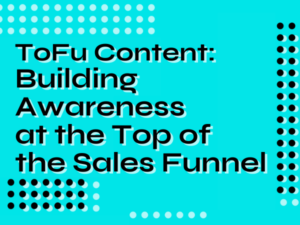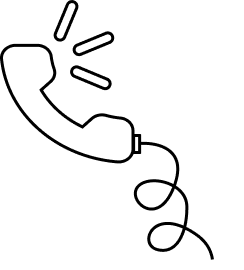Imagine your typical potential customer. You probably already know what they look like and how they might behave – but do you know how they think throughout their buying journey?
Although our current technology cannot directly read customers’ minds, we can analyze the data we have and break down the phases they navigate through as they make a purchase decision.
This is where the concept of ToFu, MoFu, and BoFu comes into play. These aren’t just catchy acronyms to rhyme your way through a marketing meeting.
With these three terms, you can ensure your messaging reaches the right people, at the right time, with the right content.
This is also where your marketing and SEO efforts meet – your content and keywords can and should be tailored to each stage of the funnel… But how exactly?
In this article, we’ll focus on the ToFu, MoFu, and BoFu sales funnel stages and how they align with SEO. We’ll also provide you with a few actionable tips you can use to boost your conversion rates. Read on!
What Is a Conversion Funnel?
Simply put, a conversion funnel (also known as a sales funnel, customer journey, or purchase funnel) is the process that represents a buyer’s decision-making process.
It illustrates the customer journey from the first contact with your brand to the ultimate goal: purchasing or subscribing to your product or service.
The funnel shape stems from the number of potential customers moving down the funnel – it usually gets smaller further in the process.
The sales funnel has many versions and interpretations, with some detailing more stages than others. However, they all boil down to the three main stages:
ToFu (Top of the Funnel): where potential customers first become aware of your business and its offerings.
MoFu (Middle of the Funnel): where potential customers evaluate your business and its competitors.
BoFu (Bottom of the Funnel): where the customers will make decisions and complete their purchases.
Not everyone who becomes aware of your brand needs your product or service, and not all those who consider your offer will eventually make a purchase.
Every stage has unique tasks and goals – including ways you implement your SEO strategy.
Understanding the ToFu (Top of the Funnel) Stage
The ToFu stage represents the initial point of contact, where the potential buyer is broadly aware of their problem or need but has yet to identify specific solutions.
Their search intent is often informational, seeking general knowledge and exploring various options. They are not yet ready to buy. Very often, they are convinced they don’t have to.
This is where they discover your brand. Not necessarily the products you offer – rather the content you serve. Chances are, you have at least some articles or guides related to your niche on your website.
The better this content is, the more likely it is to grow your brand awareness.At the core, your primary task in the first stage of the sales funnel is capturing the attention of prospects.
Given that ToFu represents the widest segment of the customer journey, it is crucial to engage them effectively, welcoming them into the world of your brand.
How Your SEO Strategy Can Help in the ToFu Stage
SEO plays a vital role in attracting new visitors to your website at this stage. Using the right keywords gives you visibility in search engine results where prospective customers begin their journey.
They are looking for answers – and you’re giving them through your content. Blog articles, guides, e-books, infographics, video content, glossaries… The list goes on and on, giving you a lot of space to best show your expertise and build trust in the early stage of the sales funnel.
Following the E-E-A-T guidelines is a good practice.Your ToFu content should exhibit Expertise, Authoritativeness, and Trustworthiness. This will not only establish your brand as a credible source of information but also increase your chances of ranking higher in search engine results.
Content marketing plays a major role in this stage, but you should not forget about other SEO tactics.
Your off-page SEO may be as important here. Apart from getting direct traffic from the websites that link to you, you also rank higher than your competitors for specific keywords thanks to the overall authority built with links.
What keywords to use?
Always tailor the keywords in your content to match the target reader’s intent.
Let’s use a practical example: imagine you’re selling baking equipment.
Instead of targeting a keyword like “buy baking equipment online” – which would be more appropriate for the BoFu stage – a ToFu keyword might look something like “best baking tips for beginners,” “how to choose the right baking pan”, or “baking hacks to save time and money.”
While this is not wrong on its own, skipping the top of the sales funnel shows you’re more focused on selling your product – and you also want to help the readers solve their problems!
AnswerThePublic is the classic example of a tool you can use when researching relevant content ideas for your ToFu audience.
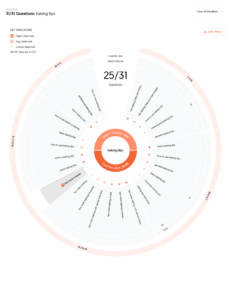
Those long tail keywords fit perfectly with the type of content typically used in the ToFu stage. They reflect informational intent – readers are looking for guides, how-to articles, and tips. They are in the “research” phase.
Advancing to the MoFu (Middle of the Funnel) Stage
The MoFu stage corresponds to a shift in the customer’s mindset. They’ve identified their problem and are now actively researching potential solutions.
In other words, you’re no longer giving your readers just the information they want but also information that nudges them toward considering your offerings as a potential solution.
Think of MoFu content as a bridge that guides your prospects through the marketing and sales journey further down the funnel, or BoFu stage.
But before we talk about closing the deal, you need to nurture the relationship with the buyer in the MoFu stage. This can be done using more detailed and targeted content types:
- Case studies: Use real-life examples to showcase how past customers benefited from your product or service.
- Product reviews and comparisons: Provide objective insights to help readers understand why your product may be the right choice for their needs.
- White papers and reports: Harness the power of data to highlight industry trends, research findings, or solutions to common problems. This content type can help establish your brand as a thought leader.
- Webinars: Engage with your audience in real time and provide valuable teachings or discussions related to your niche.
- Newsletters: Keep your audience updated with the latest happenings, insights, and offerings from your brand. Effective email marketing can maintain interest and gently nudge the prospect closer to a buying decision.
- FAQ Pages: Resolve user queries proactively. A comprehensive FAQ page can not only reduce the customer support load but also improve brand trust.
Of course, your blog posts, guides, and other forms you used in the ToFu stage can also count towards MoFu content – the difference lies in how you focus them.
MoFu content has to be narrowed down, fully engaging with specific buyer needs and expectations.How Your SEO Strategy Can Help in the MoFu Stage
At the MoFu stage, your SEO efforts take on a more direct approach. Since prospective buyers have transitioned from broad, informational searches to more focused, consideration-based searches, it’s time to optimize your content for these targeted keywords.
The intent of the buyer in the MoFu stage switches from informational to investigational and transactional. So, you should create content around MoFu keywords that cater to this intent.
Maybe you can grab their interest with phrases like “reviews of [your brand] vs. [competitor brand] mixers,” “best stand mixer for home bakers,” or “affordable baking equipment for beginners?”
The key here is to understand how the content you create can guide them towards making a purchase decision.
This is where your on-page SEO can shine. While it was important in the first stage (because you don’t want to deter your potential prospects with a terribly slow website!), in MoFu, things such as interlinking, proper keyword placement, and technical SEO become increasingly crucial.
For instance, optimizing your product and service pages can provide a seamless user experience, feeding into the buyer’s journey down the funnel.
Make sure that these pages are not just keyword-rich but also user-friendly and well-structured, and that they answer potential questions that MoFu prospects may have.
Finally, depending on your business model, local SEO can be a beneficial addition to your MoFu strategy. By optimizing your website for local search queries, you’re allowing your business to be found by prospective buyers in your area and potentially increasing conversions.
The Final Step: the BoFu (Bottom of the Funnel) Stage
As we approach the BoFu stage (or the bottom of the sales funnel) the number of potential customers has lessened.
Fear not! This decrease is not a sign of failure but rather an essential part of the sales process.
As buyers become more discerning about their options, it is natural for there to be fewer prospects at this stage compared to the ToFu stage.
Having moved through the awareness and consideration phases, your buyer is now ready to make a decision. They are now in the decisive part of the customer journey.
Sadly, you can’t just throw CTAs at them and expect them to convert. The BoFu stage is not just about closing sales; it encompasses the critical moment when you offer the final nudge, answering any last-minute concerns or questions to help the buyer make an informed decision.
In terms of the content types needed at this stage, we’re talking about things like:
- Price estimators: A great tool to present tailored prices depending on the client’s needs or in accordance with their responses to key questions.
- Deeper level product/service demos: By showing how exactly your product/service works, you are reinforcing its benefits and functionality.
- Comparison charts: Comparing your product or service with that of your competitors can be an effective sales tactic. Highlight the features where your product outshines the rest.
- Testimonials and user reviews: Social proof, especially from satisfied customers can be incredibly potent. Real user reviews and testimonials instill trust in your prospects and can tip the scales in your favor.
It is crucial to remember: content at the top, content in the middle, and content at the bottom of the funnel can all intertwine. Sometimes, the content you create for ToFu can also serve as the final encouragement at the bottom of the funnel!
Building Your BoFu SEO StrategyYour SEO helps the buyer find the content they need at critical decision-making points throughout the sales funnel stages. However, in the BoFu stage, SEO comes more as a support role to your sales pitch and BoFu content than an active digital marketing strategy.
Yet, SEO is important here, too – you don’t want a competing store to rank higher than you for phrases like “buy [your brand] mixer on sale.”
BoFu keywords are often linked directly to the purchase intent, like brand and product-specific terms and, of course, pricing info. Develop a strategy to ensure that your products are visible in search engines whenever potential customers search for them.
Additionally, using the right Schema to make your products appear directly in Google can be the last nudge needed for your potential customers to complete the sales conversion.
Why SEO Matters in All Sales Funnel Stages
It is undeniable that using SEO strategically can boost your results in your ToFu, MoFu, and BoFu stages, but your sales funnel isn’t only tied to your website and the websites linking to it.
Quite the opposite, a well-optimized website is only a part of your sales funnel. Think about other channels that help push the audience through the funnel: email marketing, paid advertising, social media, and offline promotions; they all work towards pushing the funnel to the bottom.
The overall success of your sales funnel strategy depends on how effectively you can guide your prospects from the awareness stage (ToFu) to the buying stage (BoFu).

Olga ZarrIt is undeniable that using SEO strategically can boost your results in your ToFu, MoFu, and BoFu stages, but your sales funnel isn't only tied to your website and the websites linking to it.
Quite the opposite, a well-optimized website is only a part of your sales funnel. Think about other channels that help push the audience through the funnel: email marketing, paid advertising, social media, and offline promotions; they all work towards pushing the funnel to the bottom.
SEO Consultant at SEOSLY
Therefore, the better you align each type of content marketing effort with its corresponding stage in the sales and marketing cycle, the higher the likelihood of achieving conversions.
Consider where your potential buyers are more likely to see your brand – while for most industries, Google is the most obvious answer, sometimes you can find them in Instagram feeds, YouTube tutorials, or Spotify podcasts.
Yet, regardless of where they are, a solid SEO strategy is a building block for your online presence. So, the idea of a sales funnel doesn’t exclude SEO, it actually enhances your SEO!
Buyer Intent in the ToFu, MoFu, BoFu Sales Funnel Stages
Here’s a small bonus: your customer intent cheat sheet! Use it as a guideline for planning your content for ToFu, MoFu, BoFu stages.
| Stage | Intent Type | Description | Examples |
| ToFu (Top of Funnel) | Informational: | Users are broadly aware of a problem or need and are seeking general information to understand it better. | “What are the symptoms of [disease]?” |
| Navigational: | Users seek specific websites or resources related to their problems or needs. | “[Brand name] official website” | |
| Commercial: | Users are beginning to consider potential solutions and are researching different options. | “[Product category] reviews” | |
| MoFu (Middle of Funnel) | Investigational: | Users are actively comparing different solutions and evaluating their features, benefits, and drawbacks. | “[Product A] vs. [Product B]” |
| Transactional: | Users are ready to make a purchase decision and are looking for specific information about pricing, deals, and vendors. | “[Product name] pricing” | |
| Commercial: | Users are still considering different options but are more focused on specific brands or products. | “[Brand name] alternatives” | |
| BoFu (Bottom of Funnel) | Transactional: | Users are ready to buy and are looking for information to complete the purchase. | “[Product name] discount code” |
| Commercial: | Users are comparing final options and are looking for reasons to choose one over the other. | “[Brand name] vs. competitor reviews” |
Summing Up
So, let’s tie it all together. ToFu, MoFu, and BoFu are abbreviations that represent the three stages of a content marketing funnel: Top of the Funnel, Middle of the Funnel, and Bottom of the Funnel.
The idea is simple. Your customers must see your brand (ToFu), think about how your offer can help them (MoFu), and take action and make a purchase (BoFu).
SEO can lead you through each of these stages, acting as a driving force for your content marketing strategy and online visibility.
Keep in mind that every marketing funnel stage requires a distinct yet interconnected approach. The buyer’s intent changes as they progress through the different stages of the sales process, and your content should reflect this.
Remember, SEO is an ongoing process, and continuous adaptation and improvement are key to maintaining a successful sales funnel.Embrace the power of SEO, experiment with different strategies, and watch your conversions soar!



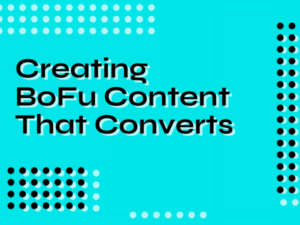
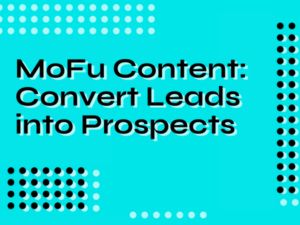
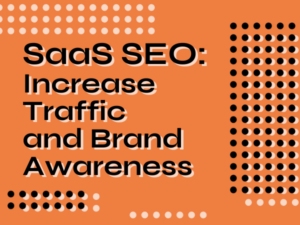
![Google March 2024 Core Update: What we know so far? [Don’t Panic]](https://non.agency/wp-content/uploads/2024/03/google-march-2024-core-update--300x225.png)
